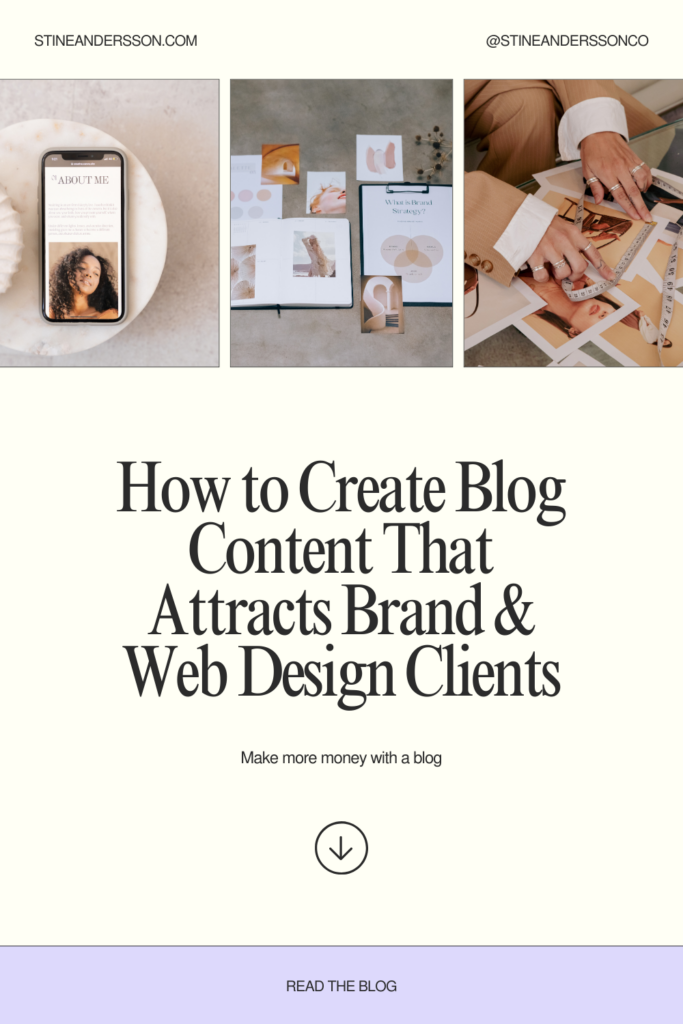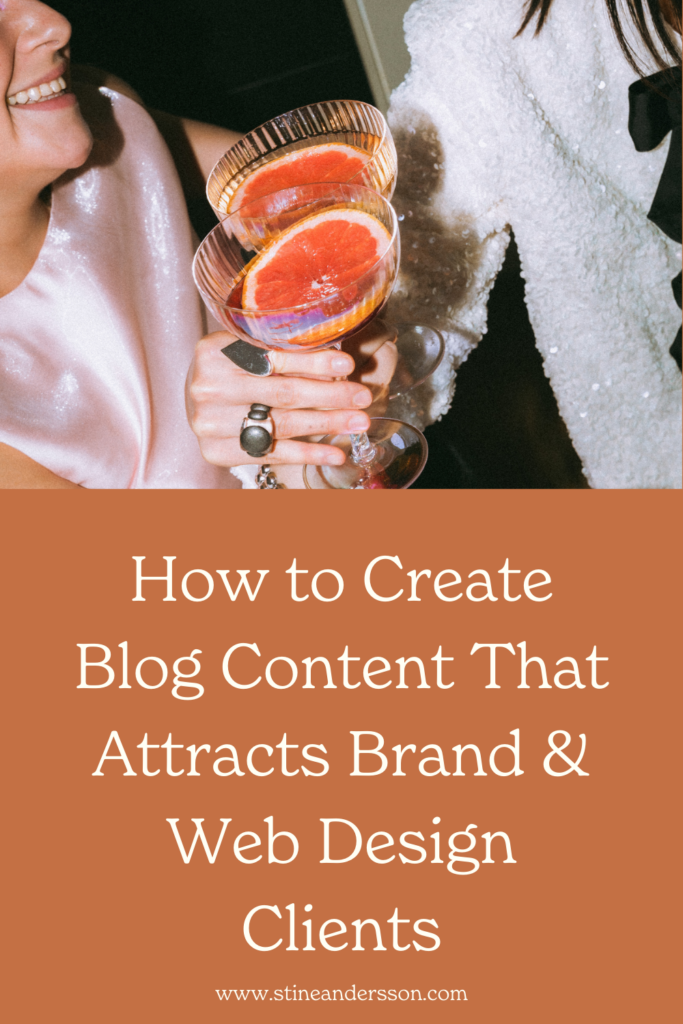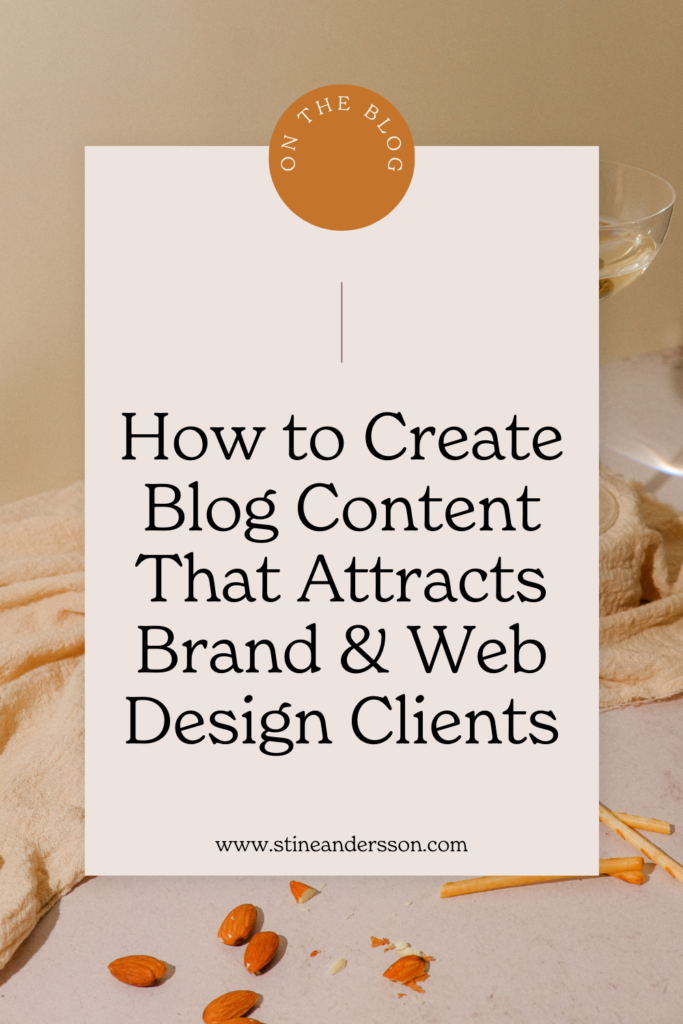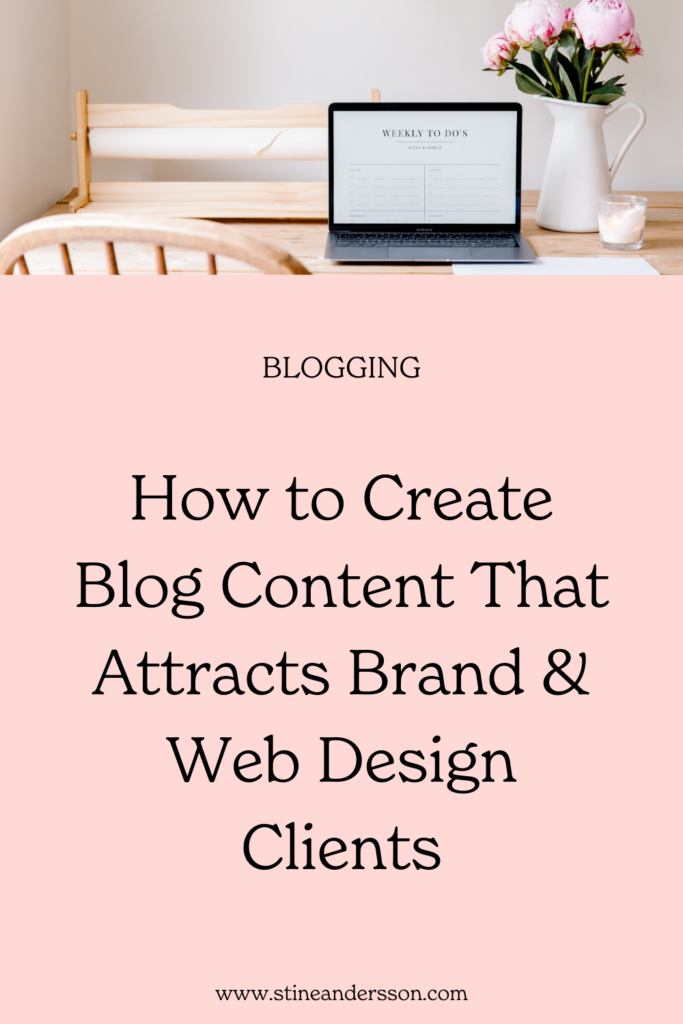Want more branding and web design clients? Let’s talk about blog strategy for designers. Stop posting random content and start writing blogs that actually bring in leads. Your blog isn’t just a place to dump your thoughts—it’s a marketing tool. With the right approach, your posts can grab attention, build trust, and turn readers into paying clients. Here’s how to do it—without the fluff.
Pin for later ⬇️

Understanding Your Target Audience
Before you write a single word, you need to understand who your ideal clients are. It’s the foundation for your new blog strategy designer! Are they small business owners struggling with their DIY branding? Are they startups that need a professionally designed website? The more you narrow down your audience, the more effective your content will be.
Identifying Your Ideal Client
Think about the type of clients you want to work with. Ask yourself:
- What industry are they in?
- What common problems do they face with branding and web design?
- What budget range are they working with?
For example, a solo entrepreneur trying to build their brand will have different concerns than an established business looking to rebrand. Your content should address their specific needs.
Researching Pain Points and Common Struggles
Your potential clients are searching for solutions. If you can identify their pain points, you can create content and a blog strategy that speaks directly to their struggles. Some common branding and web design pain points include:
- “My website isn’t converting visitors into customers.”
- “My brand looks inconsistent and unprofessional.”
- “I don’t know how to make my business stand out.”
Using Social Media and Forums for Audience Insights
Don’t just assume what your audience wants—do some research to create your blog strategy for designers! Platforms like Facebook Groups, Reddit, and LinkedIn are gold mines for discovering what people are struggling with. Look for common questions and use them as blog topics.
For example, if you see many people asking, “How do I make my website load faster?”—write a blog post about optimizing website speed.
Writing Content That Solves Real Problems
People don’t read blog posts for fun—they read them to find solutions. If your blog is full of generic content like “The History of Web Design,” it won’t attract clients. Instead, focus on writing posts that directly address problems and offer solutions.
Pin for later ⬇️

Why Generic Content Doesn’t Work for Blog Strategy for Designers
Imagine a business owner with a terrible website that’s scaring away customers. They’re not searching for “Trendy Fonts in 2024″—they need “How to Fix an Ugly Website That’s Costing You Customers.”
If you want to attract clients, you need to provide real, actionable solutions.
Addressing Client Pain Points with Actionable Advice
Here are some strong, problem-solving blog topics:
- “Your Website Looks Outdated—Here’s Why That’s Losing You Sales”
- “Why Your Brand Feels Inconsistent (And How to Fix It)”
- “Your DIY Logo Is Hurting Your Business—Here’s What to Do Instead”
These topics show that you understand client struggles and have the expertise to help them.
Examples of Client-Focused Blog Topics for Your Blog Strategy for Designers
Instead of writing about vague industry trends, write posts that offer clear, actionable advice:
❌ Bad Topic: “What is Branding?”
✅ Better Topic: “5 Branding Mistakes That Make Your Business Look Unprofessional”
❌ Bad Topic: “The Evolution of Web Design”
✅ Better Topic: “How to Design a Website That Converts Visitors into Customers”
The more focused and problem-solving your content is, the more valuable it will be to potential clients.
Showcasing Your Expertise with Case Studies
One of the best ways to turn readers into paying clients is to show them proof of your work. Case studies provide concrete evidence that you know what you’re doing.
The Power of Storytelling in Case Studies
People love real-world success stories. Instead of just saying, “I can design great websites,” show them how you helped a client improve their branding or web design.
How to Structure an Effective Case Study
- The Problem – Explain the client’s issue. What challenges were they facing?
- The Solution – Detail what you did to fix it. Did you create a new brand identity? Redesign their website? Improve UX?
- The Results – Show measurable improvements. Did they get more leads? Increase sales? Improve engagement?
Visual Elements That Make Case Studies Compelling
- Before-and-after screenshots of websites and branding
- Graphs showing improvements in conversions or sales
- Testimonials from happy clients
A well-structured case study does the selling for you. When potential clients see real results, they’re more likely to trust you and reach out.
Creating How-To Guides That Offer Value
How-to guides are some of the most effective types of blog content. They provide immediate value to your readers, positioning you as an expert.
Pin for later ⬇️

Why Tutorials Attract More Readers
People are constantly searching for solutions. If your blog post can answer their question, they’ll trust you as an authority.
Examples of Effective How-To Blog Topics
- “How to Pick the Perfect Color Palette for Your Brand”
- “The Ultimate Guide to Creating a High-Converting Homepage”
- “Step-by-Step: Fixing Your Slow Website for Better SEO”
Structuring a Step-by-Step Guide for Readability
- Use clear subheadings to break up sections
- Add bullet points and numbered lists for easy reading
- Include screenshots or graphics to illustrate key points
By making your how-to guides easy to follow, you increase the chances that readers will stay on your site longer—and eventually hire you.
Leveraging SEO to Increase Visibility
Creating great blog content isn’t enough—you need people to actually find it. That’s where Search Engine Optimization (SEO) comes into play. By optimizing your content correctly, you can attract branding and web design clients through organic search traffic.
Importance of Keyword Research
Before you start writing, research what your audience is actually searching for. Use tools like:
- Google’s Autocomplete & “People Also Ask”
- Ahrefs or Semrush for keyword data
- Ubersuggest for keyword difficulty and volume
Some high-intent keywords you could target include:
✅ “How to make a website convert leads”
✅ “Signs your branding is outdated”
✅ “Best fonts for professional branding”
These are the phrases potential clients type into Google. Writing content around these topics increases the chances of your blog showing up in search results.
Writing Optimized Blog Headlines and Meta Descriptions
Your headline is the first thing people see. Make it compelling! Compare these examples:
❌ Bad: “Web Design Mistakes”
✅ Better: “10 Web Design Mistakes That Are Killing Your Sales (And How to Fix Them)”
Your meta description is equally important. This short summary (under 160 characters) appears under your blog title in search results. It should be clear, engaging, and include your keyword.
Example:
“Struggling with low website conversions? Discover the 10 biggest web design mistakes and how to fix them for better sales.”
Internal Linking Strategies for Better SEO
Internal links help search engines understand the structure of your site and keep readers engaged. Every blog post should:
- Link to related blog posts (e.g., if writing about website speed, link to a post on UX design).
- Include a call-to-action linking to your services page.
- Use descriptive anchor text instead of “click here” (e.g., “Learn how to fix your slow website” instead of “Click here”).
With a solid SEO strategy, your blog can continue bringing in potential clients months or even years after publishing.
Promoting Your Blog for Maximum Reach
Hitting “publish” is just the beginning. If you’re not promoting your content, it’s just sitting there collecting dust.
Using Pinterest, LinkedIn, and Facebook Groups
Not every platform is useful for branding and web design clients, but these three are gold:
- Pinterest: Create eye-catching pins that link to your blog posts.
- LinkedIn: Share your content with a professional audience. Write a mini post summarizing the key points to increase engagement.
- Facebook Groups: Find groups where business owners hang out and answer questions with links to relevant blog posts.
Read more about Pinterest marketing for brand and website designers
Repurposing Content for Instagram and Email Marketing
Turn your blog posts into Instagram carousels, Reels, or Stories with quick tips from the article. You can also send out a short and engaging email summarizing your latest post with a link to read more.
Example email subject lines:
📩 “Struggling with branding? Read this before you make another mistake!”
📩 “Your website could be costing you clients—here’s how to fix it.”
Engaging with Readers Through Comments and Shares
Encourage people to comment and share your posts by:
✅ Asking questions at the end of your blogs (“What branding challenges have you faced?”)
✅ Responding to comments and engaging with readers
✅ Offering a free resource (like a checklist) in exchange for shares
By actively promoting your content, you increase visibility and attract more potential clients to your site.
Converting Readers into Clients with Strong CTAs
Even if someone loves your blog, they won’t automatically reach out—unless you tell them what to do next. Every blog post should include a clear call-to-action (CTA) that guides readers toward hiring you.
The Importance of Clear Calls-to-Action
Without a CTA, your blog is just free advice. With a CTA, it becomes a lead-generating machine. Your CTA should:
✔ Clearly state the next step (e.g., “Book a Consultation”)
✔ Be action-oriented (“Let’s create a brand that attracts clients!”)
✔ Create urgency (“Spots fill up fast—secure your consultation today!”)
Examples of CTAs That Drive Conversions
Instead of ending your blog with “Hope this helps!”, use:
👉 “Need a brand that actually attracts clients? Book a free consultation today!”
👉 “Want a website that converts? Let’s chat—click here to get started!”
👉 “Not sure where to start? Download my free Branding Checklist!”
A well-placed CTA can turn a casual reader into your next paying client.
Where to Place CTAs Within Your Blog Posts
For maximum impact, place CTAs in three key spots:
1️⃣ Near the beginning (for those who already know they need help)
2️⃣ In the middle (to capture readers who are engaged)
3️⃣ At the end (as a final push)
With strong CTAs, your blog won’t just educate readers—it will convert them into clients.
Write Smart, Get Clients
Blogging for branding and web design isn’t about writing fluff. It’s about creating content that speaks to your ideal clients, solves their problems, and convinces them to hire you.
Recap of What You Need to Do:
✅ Know your audience—write for their struggles, not yours.
✅ Solve real problems—create content that offers actionable advice.
✅ Showcase your expertise—use case studies and success stories.
✅ Optimize for SEO—help Google bring clients to you.
✅ Promote aggressively—don’t let great content go unseen.
✅ Use CTAs—make it easy for readers to become paying clients.
Do it right, and your blog will become one of your most powerful marketing tools.
Now go write something that actually gets you clients!
Pin for later ⬇️

FAQs
1. How often should I post blog content?
Quality matters more than quantity. Posting one high-value blog per week is better than churning out low-quality content daily. Create a blog strategy for designers that you can follow!
2. How long should my blog posts be?
For SEO and engagement, aim for 1,500-3,000 words. Longer posts rank better and provide more value to readers.
3. Do I need a blog if I already use social media?
Yes! A blog drives organic traffic to your website, helps with SEO, and provides evergreen content that social media alone can’t match.
4. What’s the best way to convert blog readers into clients?
Use strong CTAs, provide real value, and offer free consultations or resources to encourage action.
5. How can I improve my blog’s SEO?
- Use the right keywords – mine for this post is blog strategy for designers and I’ve repeated that over and over again
- Write engaging headlines
- Optimize images and page speed
- Link internally to related posts
- Promote your content for backlinks
By following these steps, your blog will do more than just inform—it will bring in branding and web design clients.